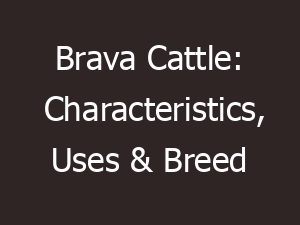The Jamaica Hope cattle are a dairy cattle breed originating from Hope Farm in Jamaica. They are also known as Jersey-Zebu or Montgomery-Jersey, and primarily raised for milk production.
Breeding for the animals started in 1910, and there was an attempt to develop an animal that was adjusted to the climate of the island. Result of that breeding program was the Jamaica Hope cattle breed.
The breed is heat tolerant and has high resistance to ticks and tick brone disease. And the breed also can produce much milk even in poor pasture land typical to tropical climates.
The whole process was to a great degree the work of Dr. Thomas Lecky, a pioneer in Jamaican agricultural science.
The Jamaica Hope cattle breed consists of approximately 80 percent Jersey, 15 percent Zebu and 5 percent Holstein. And today the breed make out about 50 percent of the total cattle population on the island.
Initial breeding (a government initiative) started with Ayrshire, Brown Swiss, Guernsey, Holstein Friesian, Jersey and Red Poll cattle breeds. The Ayrshire, Brown Swiss, Red Poll and Guernsey cattle were discontinued by a process of elimination.
Breeding of the Holstein Friesians was also ended by 1952. The Ayrshire and Brown Swiss cattle were discontinued in 1928, Red Pol in 1938 and Guernsey cattle in 1943.
And through the introduction of one Sahiwal bull imported from Pusa, India the Zebu element was added in 1920. The Jamaica Hope cattle breed is the only tropical dairy breed of cattle that results from crossing Zebu with regular cattle (apart from the Indian Taylor breed, and the newly developed Australian Milking Zebu).
The breed has gained popularity recently, and is today extensively exported to some other countries in the Caribbean, and as well as Latin America.
Today there are about 6,000 registered cows available of the breed. It has been suggested that the Jamaican Hope cattle should be bred with the Australian Milking Zebu cattle for ensuring greater genetic diversity. Read some more information about the breed below.
Jamaica Hope Cattle Characteristics
The Jamaica Hope cattle are medium sized animals. They are multi-colored animals, and they can be either horned or polled. Average live body weight of the mature cows is about 500 kg. And live body weight of the mature bulls vary from 700 to 800 kg.

Uses
These cattle are a dairy breed of cattle. They are mainly used for milk production.
Special Notes
Jamaica Hope cattle are heat tolerant and very active breed. They are well adjusted to the climate of Jamaica. The breed has high resistance to ticks and tick brone diseases.
They can produce much milk even in the poor pasture land typical to tropical climates. The cows are pretty good milk producers. And on average the cows can produce about 2500 kg of milk per lactation period of about 305 days.
Their milk is of very good quality containing about 5 percent of butter fat content. However, review full breed profile of this breed in the following chart.
| Breed Name | Jamaica Hope | |
| Other Name | Jersey-Zebu or Montgomery-Jersey | |
| Breed Purpose | Milk | |
| Special Notes | Good milkers, well adapted to local climates | |
| Breed Size | Medium | |
| Bulls | 700-800 kg | |
| Cows | Around 500 kg | |
| Climate Tolerance | Native climates | |
| Coat Color | Multi-colored | |
| Horned | Yes or polled | |
| Milk Yield | Good | |
| Rarity | Common | |
| Country/Place of Origin | Jamaica |






